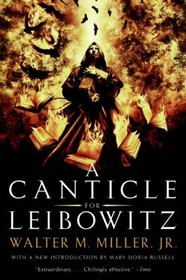Helpful Score: 3
A Canticle for Leibowitz is a cautionary tale set in a post apocalyptic America which emphasizes the adage that those who fail to learn history are doomed to repeat it. This book is actually three separate stories but all very much related and important for understanding the message of the book. The first story is probably the most popular and interesting of the three, which relates the tale of a monk in the New Mexico desert many years after a nuclear war has happened and the great lengths his order goes through to preserve knowledge. The second story takes place years later but relates to the things that the monks had done. The third story takes place perhaps a century or more later and is probably the most important part of the book and also somewhat less interesting and hard to follow, but once you understand what the third part is about, it brings the story full circle and delivers the final message that the author is trying to express. Shocking and poignant, A Canticle for Leibowitz is a true classic science fiction novel that should be read by pretty much everyone interested in the genre. 5/5 Stars.
Helpful Score: 3
I stumbled across this book in college and was blown away. Reading it again almost twenty years later, I found it hadn't lost any of its impact. I'm going to recommend it to my book club when my turn comes round again. The characters are real; their situation, though dated at points, is hauntingly affecting; their decisions, though not the ones I might have made in their place, ring true for them. The writing is sharp and lucid throughout. Sadly, I've learned that in the time between my two readings of this book, the author--who never wrote another novel after this--took his own life (a tragedy further compounded by the anti-suicide argument that takes up the last third of the book).
This is science fiction, but science fiction like 1984 or Brave New World. To break out of the (unfortunate but undeniable) science fiction ghetto, this book deserves to be filed under Classics.
Highly recommended.
This is science fiction, but science fiction like 1984 or Brave New World. To break out of the (unfortunate but undeniable) science fiction ghetto, this book deserves to be filed under Classics.
Highly recommended.
Helpful Score: 1
I first read this many years ago and found it so fascinating that I have kept my old copy of it. One image that persists is that of the monks painstakingly reproducing the blueprints they have found, not knowing what they meant or what they were for, but assuming that they are very important cultural or scientific artifacts. The last part of the book was somewhat disappointing, but even so, I expect to read it again some day.
Now it is 2012 and I just came across my old review of this book. I am amazed that there have been no more reviews posted for this book. As the one other reviewer writes, this book deserves to be listed among the classics. Isn't anyone reading it? I suppose there is hope in the fact that I found it on the Wish List today. If you can't get it here, it's worth buying, folks! My guess is that many who do buy it or get it in a swap decide to keep it.
Now it is 2012 and I just came across my old review of this book. I am amazed that there have been no more reviews posted for this book. As the one other reviewer writes, this book deserves to be listed among the classics. Isn't anyone reading it? I suppose there is hope in the fact that I found it on the Wish List today. If you can't get it here, it's worth buying, folks! My guess is that many who do buy it or get it in a swap decide to keep it.




